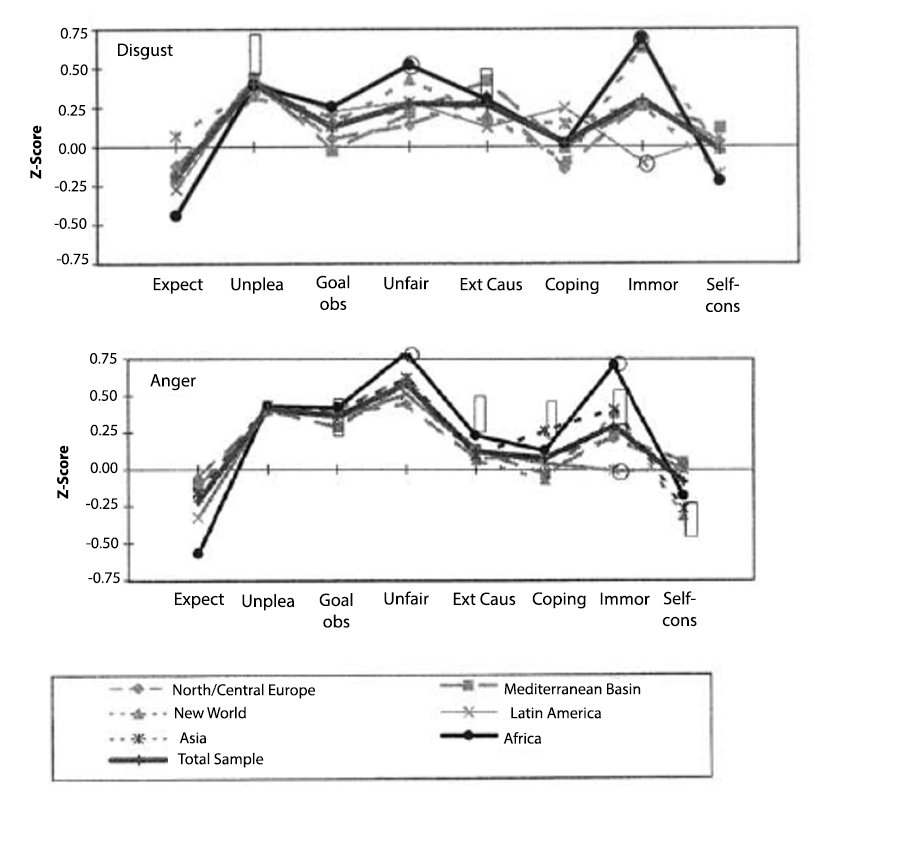Chapter 10: Disgust
Cognitive Appraisals
At the beginning of this chapter, we reviewed the eliciting events and cognitive appraisals of different types of disgust. In this section, we will review Scherer’s (1997) findings on disgust. Think about how Scherer’s (1997) findings confirm or disconfirm Rozin et al’.s (2008) disgust appraisals.
Scherer’s (1997) Study
Scherer’s (1997) study found universal and cultural differences in cognitive appraisals. For a review of Scherer’s (1997) study, go to the modern theories section on cognitive appraisals. Means (see Table 11), collapsed across all world regions, show that participants reported the following appraisals when recalling a disgust experience: unexpected, unpleasant, goal obstruction, perceived unfairness, external causation, perception that one does not need to cope, slightly immoral, and no change in self-esteem. In this table, I left the means for anger. Note that the disgust and anger means for all eight appraisals are similar. This might suggest that people make the same appraisals for both disgust and anger. In fact, in Figure 10, we can see that the cognitive appraisal patterns for anger and disgust appear similar. In Figure 10, the presence of a circle around a datapoint indicates that the country with the circle showed means significantly different from the mean of the remainder of the sample. Unfairness and immorality showed cultural differences. African countries viewed disgust as higher in unfairness and immorality, while Latin American participants reported disgust to be caused by something moral.
Table 11
Mean Changes in Cognitive Appraisal Dimensions for Disgust and Anger
| Cognitive Appraisal Dimension | Disgust Mean | Anger Mean | Question | Response Scale |
|---|---|---|---|---|
| Expectedness | 1.47 | 1.43 | Did you expect this situation to occur? | 1 = not at all; 2 = a little; 3 = very much |
| Unpleasantness | 2.90 | 2.90 | Did you find the event itself pleasant or unpleasant? | 1 = pleasant; 2 = neutral; 3 = unpleasant |
| Goal Obstruction | 2.33 | 2.55 | Did the event help or hinder you to follow your plans or achieve your aims? | 1 = it helped; 2 = it didn’t matter; 3 = it hindered |
| Unfairness | 2.25 | 2.52 | Was the situation unjust or unfair? | 1 = not at all; 2 = a little; 3 = very much |
| External Causation | 2.48 | 2.28 | Who you think was responsible for the event? | 1 = self/internal; 2 = close persons/external; 3 = other persons/external; 4 = impersonal agency/external |
| Coping Ability | 3.13 | 3.23 | How did you evaluate your ability to act on or to cope with the event and its consequences? | 1= powerless; 2 = escape possible; 3 = pretend nothing happened; 4 = no action necessary; 5 = could positively influence event and change consequences |
| Immorality | 2.25 | 2.20 | Would this behavior itself be judged as improper or immoral by your acquaintances? | 1 = not at all; 2 = a little; 3 = very much |
| Self-esteem | 1.82 | 1.77 | How did this event affect your self-esteem? | 1=negatively; 2= not at all; 3 = positively |
Adapted from “The Role of Culture in Emotion-Antecedent Appraisal,” by K.R. Scherer, 1997, Journal of Personality and Social Psychology, 73(5), p. 905, 911 (https://doi.org/10.1037/0022-3514.73.5.902). Copyright 1997 by the American Psychological Association.
Figure 10
Eight Cognitive Appraisal Ratings for Disgust and Anger across Six World Regions

Long Description
The image contains two line graphs depicting “Eight Cognitive Appraisal Ratings for Disgust and Anger across Six World Regions.” The top graph represents ratings for “Disgust” and the bottom graph for “Anger.” Both graphs have a vertical axis labeled “Z Score,” ranging from -0.75 to 0.75, and a horizontal axis with eight appraisal categories: Expect, Unplea, Goal obs, Unfair, Ext Caus, Coping, Immor, Self-cons. Each line represents a different world region: North/Central Europe, New World, Asia, Mediterranean Basin, Latin America, and Africa. Lines vary in style and marker type for distinction. There’s a legend at the bottom to match lines with regions. The plots have different fluctuations, showing how each cognitive appraisal varies across regions.
Note. Presence of a circle around a datapoint indicates that the country with the circle showed means significantly different from the mean of the remainder of the sample. Adapted from “The Role of Culture in Emotion-Antecedent Appraisal,” by K.R. Scherer, 1997, Journal of Personality and Social Psychology, 73(5), p. 912, (https://doi.org/10.1037/0022-3514.73.5.902). Copyright 1997 by the American Psychological Association.

